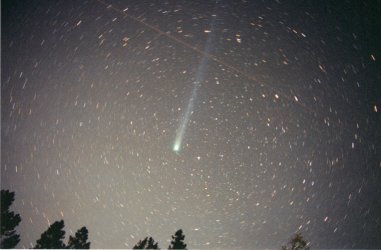American Horse
AKA "Mustang"
There are two critical things which affect our ability to see astronomical events. They are timing (day lit sky versus night) and weather or cloud cover, (not to mention local light pollution. And both of those are determined by location.
At about 6:45 this evening EST (7:45 EDT), there will be a naked eye occultation of a 2.9 magnitude star (Mu Geminorum aka TEJAT aka ZC976).
Even an ordinary event in which the star disappears behind the dark limb of the moon is worth watching, but those events in which your view is along the grazing path are thrilling. A view along the grazing path will show the star blinking and reappearing from behind hills and mountains on the moon. In the more ordinary event, as this one will be, the bright star will disappear behind the dark edge of the moon, and an hour and some 20 minutes later it reappears on the other side.
The disappearance in Baltimore, Md. as an example on the east coast, will begin with disappearance at (23h 54m 36s UT) 7:54 pm EDT, and end with Tejats reappearance at (01h 16m 39s UT) 9:16 pm EDT.
Heres Website called The International Occultation Timing Association with a CHART giving times at locations in the US which can observe this evenings occultation.
Further west in Chicago, it will begin in daylight, with Tejats disappearance at 6:33 pm CDT, with reappearance at 7:58 pm CDT, an hour after local sunset.
These are always more fun to watch with a good set of binoculars. The moon will be just east of its highest point or the zenith.
At about 6:45 this evening EST (7:45 EDT), there will be a naked eye occultation of a 2.9 magnitude star (Mu Geminorum aka TEJAT aka ZC976).
Even an ordinary event in which the star disappears behind the dark limb of the moon is worth watching, but those events in which your view is along the grazing path are thrilling. A view along the grazing path will show the star blinking and reappearing from behind hills and mountains on the moon. In the more ordinary event, as this one will be, the bright star will disappear behind the dark edge of the moon, and an hour and some 20 minutes later it reappears on the other side.
The disappearance in Baltimore, Md. as an example on the east coast, will begin with disappearance at (23h 54m 36s UT) 7:54 pm EDT, and end with Tejats reappearance at (01h 16m 39s UT) 9:16 pm EDT.
Heres Website called The International Occultation Timing Association with a CHART giving times at locations in the US which can observe this evenings occultation.
Further west in Chicago, it will begin in daylight, with Tejats disappearance at 6:33 pm CDT, with reappearance at 7:58 pm CDT, an hour after local sunset.
These are always more fun to watch with a good set of binoculars. The moon will be just east of its highest point or the zenith.
Below is a map of the viewing path of the occultation


Last edited:



